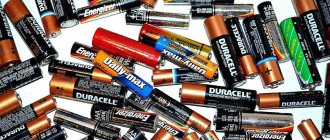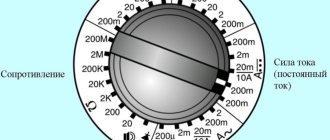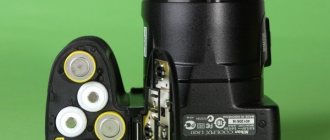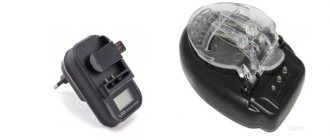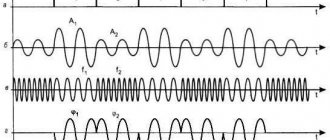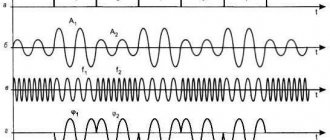In the era of technology, many electronic devices have appeared. Some models are powered by household power by plugging into an outlet. Others, mostly portable, involve the installation of power sources - batteries or accumulators. "AA batteries" are usually used for home appliances. Types, principle of operation, technical characteristics, scope of application - this is discussed in the article.
AA batteries are called AA batteries.
AA Battery Specifications
AA – cylindrical power supplies. The polarity is indicated on the case: “+” and “-”. If there is no marking, the “plus” is on the convex side. Case material – metal. The sticker contains additional information, for example, the manufacturer Duracel indicates the capacity, dimensions and weight.
AA battery sizes.
There are AA batteries and rechargeable batteries that can be reused. When the charge runs out, they are recharged.
The performance of electrical appliances depends on the parameters of galvanic cells. The characteristics of the products themselves differ, the reason being different production technologies. The features “follow” from this.
As for the dimensions, the diameter of the batteries is 13.5 – 14.5 mm, height – 50.5 mm. Voltage parameter – from
1.2 to 1.5 V. The terminals are installed at the ends. The “plus” has a diameter of 5.5 mm and a height of just under 1 mm. “Minus” is a flat surface on the opposite side with a diameter of about 7 mm.
The density of electrically conductive liquids imprisoned in the battery case varies, and the weight of the products varies from this - 14 - 30 g.
Depending on what kind of electrolyte is poured, there are the following varieties:
- saline;
- alkaline (the second name is alkaline);
- lithium
Characteristics in the table.
| Type | Marking | Capacity (mAh) | Voltage (V) |
| Saline | R6 | 550 – 1500 | 1.5 |
| Alkaline | LR6 | 2700 – 3000 | 1.5 |
| Lithium | FR6 | 3000 – 3500 | 1.5 |
If there is an inscription on the case “Do not recharge!”, then the power source does not require recharging. What other markings are found: 316, A316, Mignon, Stilo, MN1500, MX1500, etc.
How to measure capacitance
The multimeter can also be used as a tester to measure battery capacity. The battery capacity can be measured using a test battery discharge. To check the capacity, you will first need to fully charge the battery. Then you need to make sure that the battery is fully charged by measuring the voltage and density of the electrolyte.
Next, you need to connect a load of known power, for example a 24 W incandescent lamp, and note the exact start time of this experiment. When the battery voltage drops to 50% percent of the previously set reading of a fully charged battery, the light should be turned off.
Capacity measurement, which is expressed in a/h, is carried out by multiplying the current in the circuit with a connected load by the number of hours during which the control discharge of the battery was carried out. If you get a value that is as close as possible to the nominal a/h value, then the battery is in excellent condition.
Design and principle of operation
AA batteries, produced in the 1920s, were already compact, lightweight and affordable, and therefore popular. They consisted of a graphite rod, manganese oxide and a zinc “cup”. Today, batteries look different, but work on the same principle.
Batteries currently produced are cylindrical products, the “body” of which is filled with electrolyte as a conductive liquid. The housing serves as protection against rust and short circuits. The function of the electrolyte is to saturate the active material of the battery and the electrodes (+ and -). As a result, when ions begin to move from one electrode to another, a current is generated.
Batteries have a lifespan. And the older they are, the weaker the chemical reaction in the electrolyte is - the power source “runs out”.
What is a load fork?
Standard load plugs are often manufactured in the form of voltmeters with a handle with the ability to connect the load in parallel with the voltmeter itself. The load is carried out in the form of a spiral, which has the functions of connecting in various ways. There are plugs that can be connected to battery banks, and there are devices for testing 12-volt batteries - when the load is connected using a nut.
Modern plugs are equipped with a liquid crystal display and, as a rule, have several load modes. To test conventional batteries, a plug with a current load of 100 A will be sufficient.
Any load plug is one of the elements of a closed electrical circuit, which has a fairly high power rating. The simplest version of such a device consists of a voltmeter, a wire resistor and two clamps.
There are many options on how to make a load fork yourself. As the saying goes, “there would be enough junk in the garage.” Because it is often made from improvised means, based on the fact that it is used infrequently, and it is not at all necessary to buy it specifically. The main thing is that the electrical circuit is built correctly, in accordance with simple calculations.
Kinds
A different active substance is poured inside the galvanic cells, and the metal of the cathode is also different. This is one of the classifiers.
Salt
The electrolyte is ammonium chloride, the electrodes are made of zinc and manganese oxide. The advantage is accessibility. There are enough features close to disadvantages:
- during the discharge, the voltage drops, and if the load current exceeds 100 mA, they stop working;
- service life does not exceed two years;
- high self-discharge - if the battery is used for a long time, the capacity level from the initial one can drop to 30%, and this is before the warranty period expires;
- cannot stand sub-zero temperatures - the container immediately “goes” to 0.
However, if no load is applied to the salt batteries, they self-heal. This can be explained by the homogeneity of the electrolyte composite.
A feature of power supplies is their low operating current, so they power low-power electrical appliances: watches, devices with LCD indicators, remote controls, etc.
AA salt battery.
Alkaline
Another name is alkaline (you can often find the word ALKALINE on batteries). Used since 1964. The anode is zinc, the cathode is made of manganese dioxide. The electrolyte is potassium hydroxide (KOH) or other alkali.
Alkaline, in comparison with other AA products, are the most common due to their advantages:
- last longer than salt batteries;
- work better at low temperatures;
- more sealed housing, which reduces the likelihood of electrolyte leakage;
- low level of self-discharge, and the storage guarantee, on the contrary, has been increased.
Negative qualities:
- voltage drops due to discharge;
- more expensive and heavier than salt ones.
Pin-type alkaline AA power supplies are optimal for electrical appliances with current consumption up to 250 mA. If the current is higher, the batteries will quickly run out; therefore, they are not suitable for photo and video equipment, equipment with high current consumption. They can withstand increased loads, but only for a short time.
Lithium
The cathode is made of lithium, the electrolyte is organic. The liquid medium impregnates the diaphragm, separated from the “minus” by a separator. Lithium batteries are more expensive than salt and alkaline batteries, but at the same time they have better technical characteristics. Their positive properties:
Differences in the composition of different types of batteries.
- the capacity level is 1.5 – 3 times higher than that of alkaline batteries, and 30 times compared to salt batteries;
- low level of self-discharge, and the guaranteed shelf life reaches 12 years;
- operate at temperatures from -40 to +40°;
- easier;
- maintain voltage at different load currents.
Power supplies with organic electrolyte are used on electrical appliances with different current consumption. They work well with photo and video cameras.
In addition to AA batteries, there are also rechargeable batteries. The marking is 14500. The voltage level is 3.7 V. It cannot be used instead of a battery due to the high output voltage.
Lithium power supplies are used with a dummy emulator, which allows the voltage to be increased by 0.7 V.
How to store new batteries so as not to lose their power
Batteries must be stored in their original packaging; this protects the batteries from the negative influences of the external environment and also protects them from moisture penetration. In addition, keeping the batteries in a packaged state makes it possible not to confuse new batteries with old ones, and also prevents the input contacts from interacting with metal objects.
Read also: How to find out the power of a screwdriver in watts
It should be sorted by production date and manufacturer. The fact is that batteries made by different manufacturers can react with each other, resulting in charge leakage and other problems. In addition, it is recommended to place each battery in a plastic bag.
If rechargeable batteries are subject to storage, you must first check their charge, as they can deteriorate if stored in a discharged state.
It is recommended to conserve batteries at room or lower temperatures. Many products of this type are kept in a cool place out of direct sunlight.
The safety of batteries does not include placing them in the refrigerator, unless the manufacturer specifies this method of storage. If they are stored in the refrigerator, they must be warmed before use.
High air humidity also negatively affects the functional properties of the product. To avoid the risk of getting wet, batteries must be placed in an airtight container.
In addition, it is desirable to prevent contact of the product with conductors. When the battery comes into contact with metal, an electric current passes through it, causing it to quickly discharge.
It is also not recommended to keep products in metal containers, as well as storing them together with objects made of metal. Experts advise: place the batteries so that they do not come into contact with the positive and negative poles.
A load plug is a device necessary to determine the degree of charge and serviceability of a car battery. With its help, you can determine the battery voltage level at idle speed and under load. A load fork for a battery can also be made with your own hands - if you have certain skills and abilities.
Differences from AAA
AA or AAA - so that the buyer does not get confused, these letters are written on the body in large font. The difference between batteries is size. The latter are smaller, which is why they are popularly called “little-finger”. Their diameter is 10.5 mm, height is 44.6 mm.
By the way, the voltage level of AA and AAA is approximately the same, but AA batteries have a higher capacity.
How to check leakage current
The battery may discharge on its own, even if its terminals are not connected to electrical consumers. The amount of self-discharge is indicated in the documentation for the battery and is a natural process. The loss of electricity can be especially noticeable in acid batteries.
In addition to natural electrical leakage, there may be areas of the circuit that are wet or have thin insulation. In this case, even when all electricity consumers are turned off, an additional current leak occurs, which can lead to a complete discharge of the battery, and in some cases, to a fire in the damaged area.
Especially, this phenomenon can be dangerous in the on-board network of a car, in which the negative conductor is the entire body and components, which may contain a sufficient amount of flammable substances to form an open flame even from a small spark or electric arc.
To identify such “unauthorized” consumption of electricity, it is necessary to turn off the car’s ignition, as well as turn off devices operating in “standby mode”, such as a radio and alarm system.
You can measure the current on the battery using a multimeter only if the measuring device is switched to the current measurement mode, indicated by the “10 A” icon. To do this, the circular switch is switched to the appropriate mode, and the red plug is placed in the socket marked “10 ADC”.
The red probe of the multimeter is connected to the “+” of the battery, and the black probe is connected to the disconnected terminal. At this moment, there should be no readings from the device at all. If the multimeter shows any value, then the leakage current is significant, and it is necessary to carry out a detailed diagnosis of the vehicle’s on-board network.
Leakage is measured in other electronic systems in a similar way. When carrying out diagnostics, care should be taken, and if you suspect a significant electrical leakage, which is manifested by sparking when disconnecting or connecting a terminal, you should refuse to measure the leakage current with a multimeter.
If you neglect this rule, you can “burn” the device, which is not designed to test large current values.
Popular manufacturers
The portable battery market is represented by a wide selection of manufacturers.
- Duracell. World famous brand. Manufactures several types of rechargeable batteries. Sizes are made for various household appliances.
- Energizer. Second most popular brand. Manufactured in the USA for a variety of home appliances. Distributed throughout the world.
- Maxell. Battery manufacturing company in Japan. Manufactures disposable and reusable batteries. All types suitable for batteries are used as manufacturing materials.
- Panasonic. Produces all types of power supplies. Produces disposable and reusable batteries. Users prefer to purchase the Panasonic brand rather than the National brand. It is also a derivative of them, and produces the same characteristics.
Conclusion
The portable power supply market is filled with a variety of brands. They meet all requests from various consumers. High capacity, low weight, long life, high voltage - the list goes on and on.
An important factor is the price factor. Every buyer will be able to find something suitable according to their price range. Naturally, price affects quality - this aspect should be taken into account when purchasing a power source. The more popular and expensive the brand, it is believed that it will last longer.
When purchasing power supplies at retail, the user pays more. Experienced buyers advise purchasing batteries in packages of several pieces. The cost of a “wholesale” purchase will be less, and therefore more profitable.
The cost in online stores may differ from the purchase from the “counter”. This factor is based on the lack of payment to sellers, store rental and other nuances. But it is advisable to order in stores with free delivery, otherwise a “cheap” battery purchased on the Internet will cost more than a battery purchased from the “counter”.
Good luck choosing portable power sources.
